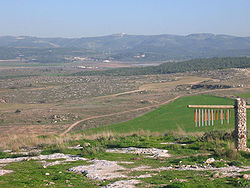Ayalon Valley


The Ayalon Valley (Hebrew: אַיָּלוֹן or איילון, ʾAyyālōn), also written Aijalon and Ajalon, is a valley in the lowland of the Shephelah in Israel.
The Ayalon Valley has been an important route connecting the coastal plain and Jerusalem for generations. Due to its location, several battles were fought in its vicinity. The Hebrew Bible gives the valley its name from Ayalon, a city that the Tribe of Dan possessed before their migration to the north. In the modern period, ancient Ayalon was identified with the former village of Yalo at the base of the Bethoron pass, which preserved the ancient, biblical name.[1]
Today, the Ayalon Valley is home to several .
History
In the
Ajalon is mentioned in the accounts of an invasion of Canaan by the Egyptian king
Joshua's battle
The Valley of Ayalon was first mentioned in the
Tribe of Dan
Following the conquest, the city of Ajalon was apportioned to the Tribe of Dan (Joshua 19:42) and was designated as one of the Levitical cities given to the Kohathites (Joshua 21:24 and 1 Chronicles 6:69). In spite of Joshua's initial victory in the Valley of Ajalon, the Amorites continued to live in the city of Ajalon (Judges 1:34–35). Constant Philistine pressure to control the valleys of the Shephelah forced the tribe of Dan to retreat westward, reducing the extent of their territory. Eventually, the Danites abandoned their initial inheritance in the Aijalon area and moved to the extreme northern part of Israel, settling in the city of Laish, which they renamed Dan (Judges 18).
The location was also the site of a great victory over the
After the kingdom divided, Ajalon became the boundary between the kingdoms of Judah and Israel. Rehoboam, the first king of Judah, fortified the city of Aijalon, supplying officers, weapons and food provisions (2 Chronicles 11:5–12).
Identification
Ajalon's identification with
Sites
Canada Park,[5] Yad La-Shiryon,[6] the International Center for the Study of Bird Migration[7] and the Latrun Monastery[8] are located in the Ayalon Valley.

See also
- Tel Aviv–Jerusalem railway
- Geography of Israel
- Geography of the State of Palestine
- Cities in the Book of Joshua
References
- ISBN 978-0-310-49235-1.
- ^ Claude Reignier Conder (1894). The Tell Amarna Tablets (2nd ed.).
- S2CID 170437101.
- ^ Robinson and Smith, 1860, p. 253-254.
- ^ "Ayalon Canada Park - Biblical and Modern Israel".
- ^ "אתר יד לשריון - חיל השריון מאז ועד היום".
- ^ "Israel: The Bird's Eye View". Archived from the original on 2014-04-19. Retrieved 2014-04-18.
- ^ "HOLY WINE - Domain de Latroune Wine". www.holy-wine.com. Archived from the original on 30 November 2022. Retrieved 2023-03-18.
Bibliography
- Robinson, Edward and Eli Smith (1860). Biblical Researches in Palestine and Adjacent Regions: A Journal of Travels in the Year 1838. Crocker and Brewster.
- Robinson, Edward and Eli Smith (1856). Later Biblical Researches in Palestine and Adjacent Regions: A Journal of Travels in the Year 1852. J. Murray.
